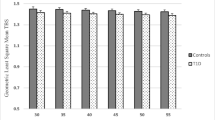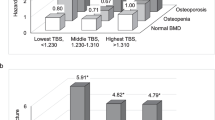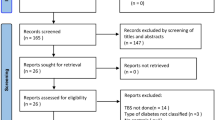Abstract
Summary
Trabecular bone score (TBS) seems to provide additive value on BMD to identify individuals with prevalent fractures in T1D. TBS did not significantly differ between T1D patients and healthy controls, but TBS and HbA1c were independently associated with prevalent fractures in T1D. A TBS cutoff <1.42 reflected prevalent fractures with 91.7 % sensitivity and 43.2 % specificity.
Introduction
Type 1 diabetes (T1D) increases the risk of osteoporotic fractures. TBS was recently proposed as an indirect measure of bone microarchitecture. This study aimed at investigating the TBS in T1D patients and healthy controls. Associations with prevalent fractures were tested.
Methods
One hundred nineteen T1D patients (59 males, 60 premenopausal females; mean age 43.4 ± 8.9 years) and 68 healthy controls matched for gender, age, and body mass index (BMI) were analyzed. The TBS was calculated in the lumbar region, based on two-dimensional (2D) projections of DXA assessments.
Results
TBS was 1.357 ± 0.129 in T1D patients and 1.389 ± 0.085 in controls (p = 0.075). T1D patients with prevalent fractures (n = 24) had a significantly lower TBS than T1D patients without fractures (1.309 ± 0.125 versus 1.370 ± 0.127, p = 0.04). The presence of fractures in T1D was associated with lower TBS (odds ratio = 0.024, 95 % confidence interval (CI) = 0.001–0.875; p = 0.042) but not with age or BMI. TBS and HbA1c were independently associated with fractures. The area-under-the curve (AUC) of TBS was similar to that of total hip BMD in discriminating T1D patients with or without prevalent fractures. In this set-up, a TBS cutoff <1.42 discriminated the presence of fractures with a sensitivity of 91.7 % and a specificity of 43.2 %.
Conclusions
TBS values are lower in T1D patients with prevalent fractures, suggesting an alteration of bone strength in this subgroup of patients. Reliable TBS cutoffs for the prediction of fracture risk in T1D need to be determined in larger prospective studies.



Similar content being viewed by others
Abbreviations
- BMD:
-
Bone mineral density
- BMI:
-
Body mass index
- HbA1c :
-
Glycated hemoglobin A 1c
- SD:
-
Standard deviation
- TBS:
-
Trabecular bone score
References
Nicodemus KK, Folsom AR (2001) Type 1 and type 2 diabetes and incident hip fractures in postmenopausal women. Diabetes Care 24:1192–1197
Vestergaard P (2007) Discrepancies in bone mineral density and fracture risk in patients with type 1 and type 2 diabetes—a meta-analysis. Osteoporos Int 18:427–444
Hofbauer LC, Brueck CC, Singh SK, Dobnig H (2007) Osteoporosis in patients with diabetes mellitus. J Bone Miner Res 22:1317–1328
Neumann T, Lodes S, Kastner B, Franke S, Kiehntopf M, Lehmann T, Muller UA, Wolf G, Samann A (2014) High serum pentosidine but not esRAGE is associated with prevalent fractures in type 1 diabetes independent of bone mineral density and glycaemic control. Osteoporos Int 25:1527–1533
Bousson V, Bergot C, Sutter B, Levitz P, Cortet B (2012) Trabecular bone score (TBS): available knowledge, clinical relevance, and future prospects. Osteoporos Int 23:1489–1501
Pothuaud L, Carceller P, Hans D (2008) Correlations between grey-level variations in 2D projection images (TBS) and 3D microarchitecture: applications in the study of human trabecular bone microarchitecture. Bone 42:775–787
Roux JP, Wegrzyn J, Boutroy S, Bouxsein ML, Hans D, Chapurlat R (2013) The predictive value of trabecular bone score (TBS) on whole lumbar vertebrae mechanics: an ex vivo study. Osteoporos Int 24:2455–2460
Silva BC, Leslie WD, Resch H, Lamy O, Lesnyak O, Binkley N, McCloskey EV, Kanis JA, Bilezikian JP (2014) Trabecular bone score: a noninvasive analytical method based upon the DXA image. J Bone Miner Res 29:518–530
Hans D, Goertzen AL, Krieg MA, Leslie WD (2011) Bone microarchitecture assessed by TBS predicts osteoporotic fractures independent of bone density: the Manitoba study. J Bone Miner Res 26:2762–2769
Popp AW, Buffat H, Eberli U, Lippuner K, Ernst M, Richards RG, Stadelmann VA, Windolf M (2014) Microstructural parameters of bone evaluated using HR-pQCT correlate with the DXA-derived cortical index and the trabecular bone score in a cohort of randomly selected premenopausal women. PLoS ONE 9:e88946
Winzenrieth R, Dufour R, Pothuaud L, Hans D (2010) A retrospective case–control study assessing the role of trabecular bone score in postmenopausal Caucasian women with osteopenia: analyzing the odds of vertebral fracture. Calcif Tissue Int 86:104–109
Dhaliwal R, Cibula D, Ghosh C, Weinstock RS, Moses AM (2014) Bone quality assessment in type 2 diabetes mellitus. Osteoporos Int 25:1969–1973
Leslie WD, Aubry-Rozier B, Lamy O, Hans D (2013) TBS (trabecular bone score) and diabetes-related fracture risk. J Clin Endocrinol Metab 98:602–609
Neumann T, Samann A, Lodes S et al (2011) Glycaemic control is positively associated with prevalent fractures but not with bone mineral density in patients with type 1 diabetes. Diabet Med 28:872–875
Hans D, Barthe N, Boutroy S, Pothuaud L, Winzenrieth R, Krieg MA (2011) Correlations between trabecular bone score, measured using anteroposterior dual-energy X-ray absorptiometry acquisition, and 3-dimensional parameters of bone microarchitecture: an experimental study on human cadaver vertebrae. J Clin Densitom 14:302–312
(2001) NIH Consensus Development Panel on Osteoporosis Prevention, Diagnosis, and Therapy, March 7–29, 2000: highlights of the conference. South Med J 94:569–573
Cummings SR (1985) Are patients with hip fractures more osteoporotic? Review of the evidence. Am J Med 78:487–494
Schwartz AV, Vittinghoff E, Bauer DC et al (2011) Association of BMD and FRAX score with risk of fracture in older adults with type 2 diabetes. JAMA 305:2184–2192
Ferrari S, Bianchi ML, Eisman JA, Foldes AJ, Adami S, Wahl DA, Stepan JJ, de Vernejoul MC, Kaufman JM (2012) Osteoporosis in young adults: pathophysiology, diagnosis, and management. Osteoporos Int 23:2735–2748
Armas LA, Akhter MP, Drincic A, Recker RR (2012) Trabecular bone histomorphometry in humans with type 1 diabetes mellitus. Bone 50:91–96
Breban S, Briot K, Kolta S, Paternotte S, Ghazi M, Fechtenbaum J, Roux C (2012) Identification of rheumatoid arthritis patients with vertebral fractures using bone mineral density and trabecular bone score. J Clin Densitom 15:260–266
Romagnoli E, Cipriani C, Nofroni I et al (2013) "Trabecular Bone Score" (TBS): an indirect measure of bone micro-architecture in postmenopausal patients with primary hyperparathyroidism. Bone 53:154–159
Boutroy S, Hans D, Sornay-Rendu E, Vilayphiou N, Winzenrieth R, Chapurlat R (2013) Trabecular bone score improves fracture risk prediction in non-osteoporotic women: the OFELY study. Osteoporos Int 24:77–85
Dufour R, Winzenrieth R, Heraud A, Hans D, Mehsen N (2013) Generation and validation of a normative, age-specific reference curve for lumbar spine trabecular bone score (TBS) in French women. Osteoporos Int 24:2837–2846
Acknowledgments
The authors thank Ernesta Palombo-Kinne (Jena) for critical revision of the manuscript.
Conflict of interest
TBS iNsight Software is a product of Med-Imaps. Didier Hans is co-owner of the TBS patent and has corresponding ownership shares. Thomas Neumann, Sabine Lodes, Bettina Kästner, Thomas Lehmann, Olivier Lamy, Ulrich Alfons Müller, Gunter Wolf, and Alexander Sämann declare that they have no conflict of interest.
Funding
The study was funded by a grant of Merck Pharma GmbH, Germany.
Author information
Authors and Affiliations
Corresponding author
Additional information
The study was conducted according to the principles of the Declaration of Helsinki.
Rights and permissions
About this article
Cite this article
Neumann, T., Lodes, S., Kästner, B. et al. Trabecular bone score in type 1 diabetes—a cross-sectional study. Osteoporos Int 27, 127–133 (2016). https://doi.org/10.1007/s00198-015-3222-y
Received:
Accepted:
Published:
Issue Date:
DOI: https://doi.org/10.1007/s00198-015-3222-y




